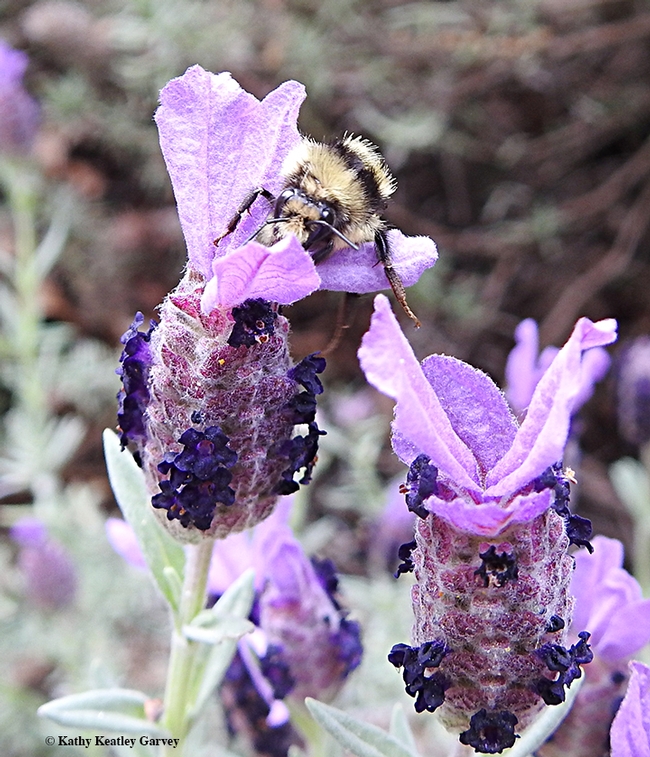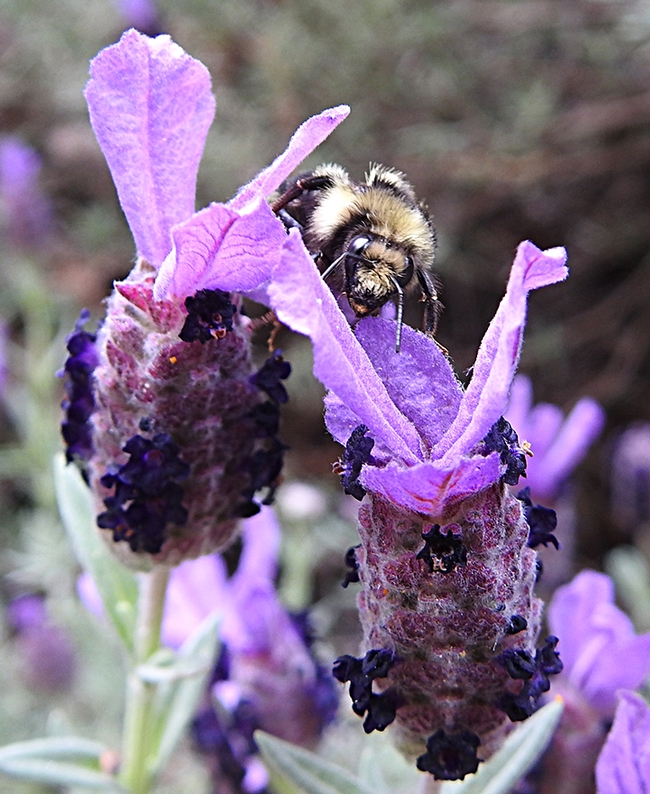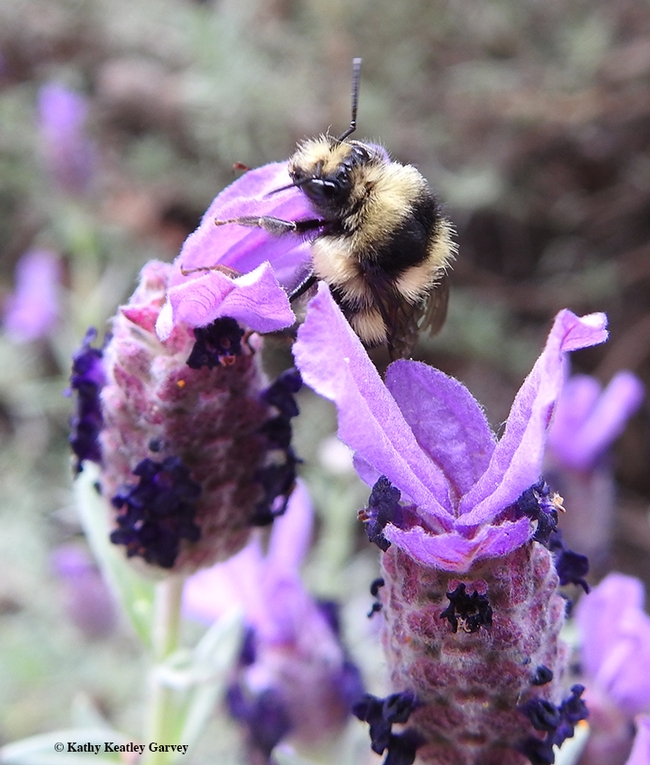- Author: Kathy Keatley Garvey
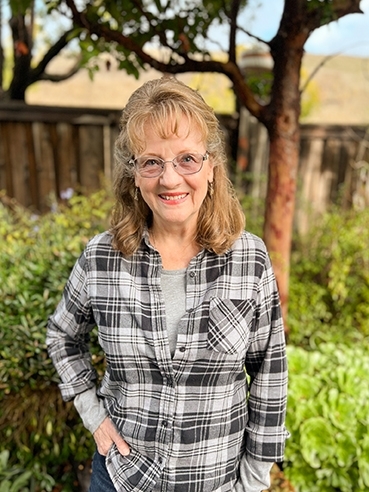
You take a video, email it to the sponsor, the Bohart Museum of Entomology, and you win the 4th annual Robbin Thorp Memorial First-Bumble-Bee-of-the-Year Contest
Congratulations, Nancy Hansen! The Fairfield resident emailed her video of a black-tailed bumble bee, Bombus melanopygus, at 10:57 a.m., Monday, Jan. 1 to the Bohart Museum. (See her video on YouTube)
Contest coordinator Lynn Kimsey, UC Davis distinguished professor of entomology and director of the Bohart Museum, applauded the winner as the earliest ever recipient, and the first from Solano County.
Contest rules state that the first person to photograph a bumble bee in either Yolo or Solano and email it to the sponsor, the Bohart Museum, will receive a coffee cup designed with the endangered Franklin's bumble bee, the bee that the legendary Robbin Thorp (1933-2019), a UC Davis distinguished emeritus professor and a 30-year member of the Department of Entomology and Nematology faculty, monitored for decades.
"I've lived in Fairfield since 1970 and I retired from Kaiser Medical Center Vallejo after 33 years," Hansen said. "I'm a longtime gardener and flower-aholic! I'm very interested in soil health, pollinators and in soil microbes. I didn't plant the Madrone tree but I'm happy it provides food for pollinators most of the year. The first year we lived here, 2017, the tree was full of bees. Their buzz sounded like an airplane engine, but since then I've seen fewer and fewer bees."
"On Monday I was out back enjoying the bit of sunshine that had peaked through the clouds when I heard buzzing in my Madrone tree. I went over, looked and I saw a lot of honey bees, but then I looked up and saw the bumble bee. I ran to get my camera hoping I could catch his picture before he flew away."
Hansen retired as a cardiology technician at Vallejo's Kaiser facility, where she performed the cardiology testing for the doctors. "It was one of the most interesting and varied jobs in the facility," she said. "I learned so much during my working years. I was in charge of training new employees so I was able to pass that knowledge on."
Previous record-holders:
2023: Ria deGrassi of Davis, who photographed a B. melanopygus at 12:32, Jan. 8 on a ceanothus in her yard.
2022: Tie between Maureen Page, then a doctoral candidate in the lab of pollination ecologist Neal Williams, professor, UC Davis Department of Entomology and Nematology; and Ellen Zagory of Davis, retired director of public horticulture for the UC Davis Arboretum and Public Garden. Each photographed a bumble bee on manzanita in the Arboretum at 2:30 p.m., Jan. 1. Page photographed a B. melanopygus, while Zagory captured an image of the yellow-faced bumble bee, Bombus vosnesenskii.
2021: UC Davis postdoctoral researcher Charlie Casey Nicholson, then of the Williams lab and the Elina Lastro Niño lab, photographed a B. melanopygus at 3:10 p.m., Jan. 14 in a manzanita patch in the Arboretum.
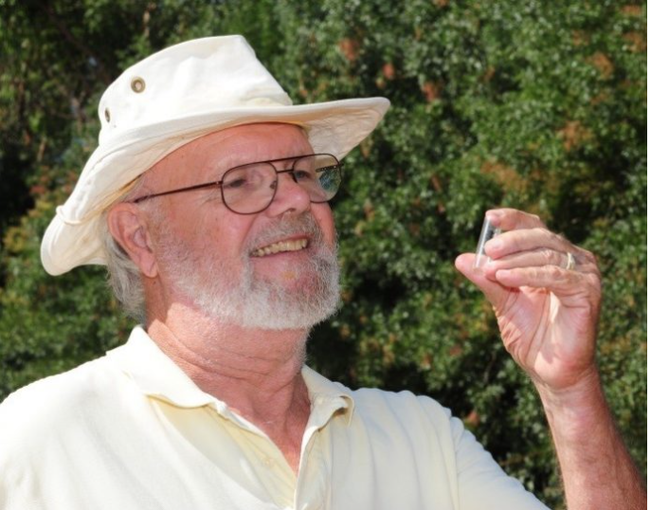
Thorp, a tireless advocate of pollinator species protection and conservation, co-authored two books in 2014, during his retirement: Bumble Bees of North America: An Identification Guide (Princeton University,) and California Bees and Blooms: A Guide for Gardeners and Naturalists (Heyday). Every year he looked forward to finding or seeing the first bumble bee in the area.
Thorp co-taught The Bee Course from 2002 to 2019. An intensive nine-day workshop affiliated with the American Museum of Natural History and held annually at the Southwestern Research Station, Portal, Ariz., it draws participants from around the world, including conservation biologists, pollination ecologists, and other biologists who want to gain greater knowledge of the systematics and biology of bees.
For years, Thorp monitored Franklin's bumble bee, found only in a small range in Southern Oregon and Northern California, and now feared extinct. He last spotted it in 2006.
Soon Nancy Hansen will receive a coffee cup with an image of that bee.
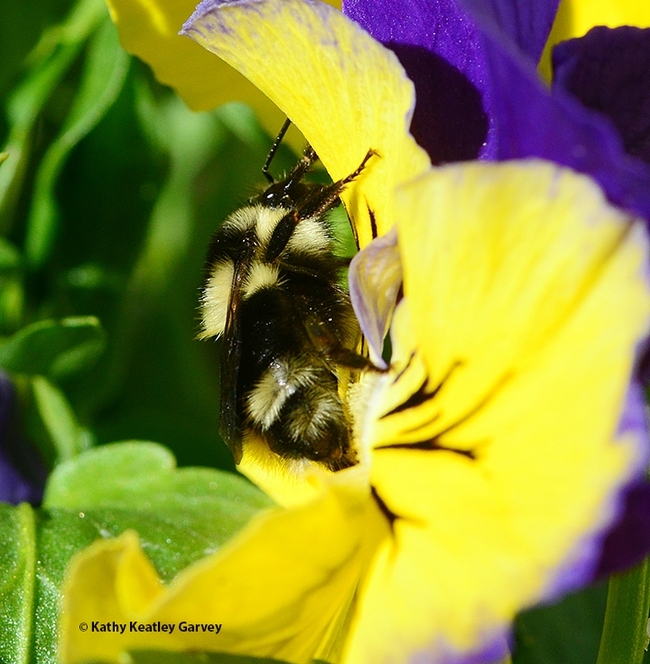
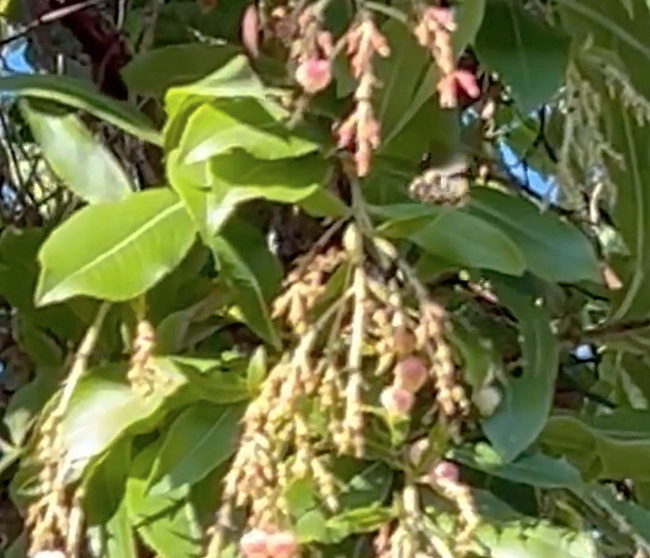
- Author: Kathy Keatley Garvey
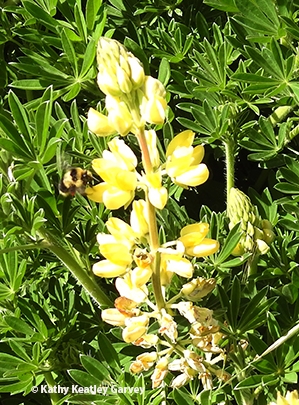
Windy? 27 mph!
We didn't think we'd see a single bumble bee foraging on the blooming ice plants, poppies, wild radishes, or lupines, but there it was, a black-tailed bumble bee, Bombus melanopygus, nectaring on a yellow lupine near the entrance to Doran Regional Park.
This bumble bee species is one of the earliest to emerge in the spring. We've seen it as early as Jan. 1 in Benicia. And the Bohart Museum of Entomology, UC Davis, coordinates a contest to see who can find and photograph the first bumble bee of the year in the two-county area of Yolo and Solano. This year Ria de Grassi of Davis spotted a B. melanopygus, foraging on her ceanothus plant in her backyard on Jan. 8. (See Bug Squad blog.)
But back to the Bombus at Bodega. How can a tiny bumble bee, ranging from 0.6 to 1 inch in length, withstand that 27 mph wind, which seemed near gale force? Bumble bees pay no attention to gale force, which the National Weather Service defines as between 34 and 47 knots (39 to 54 mph).
Bumble bee authority John Ascher messaged me: "Their flight and resistance to cold is amazing!" Truly!
"Powerful flight muscles are packed into their stout little bodies, which are covered in thick fur," according to an Aug. 2, 2021 post in Imprint Ecology, Chichester, West Sussex, England. "These can propel them through high winds, in comparison to honeybees and butterflies who find it difficult to get airborne in wind above 20 mph. In addition, bumblebees can dislocate their flight muscles and shiver them to keep warm which is very useful on wet, windy days. Even in winter, you can see big queen bumblebees happily foraging on gorse, heather and crocus, when no other insects are out and temperatures have barely reached double figures."
"Bumblebees evolved in the Himalayas, around 25 to 40 million years ago. They are designed to withstand bleak, windy, mountainous climates and don't actually fare very well in hot places."
The black-tailed bumble bee predominantly has pale yellow hair "with bands of black hair between the wing bases and across the middle of the abdomen," according to the quartet of UC-based scientists, Gordon Frankie, (the late) Robbin Thorp, Rollin Coville and Barbara Ertter, in their book, California Bees and Blooms: A Guide for Gardeners and Naturalists.
They also forage quickly, especially in a strong wind...or an uninvited gust.
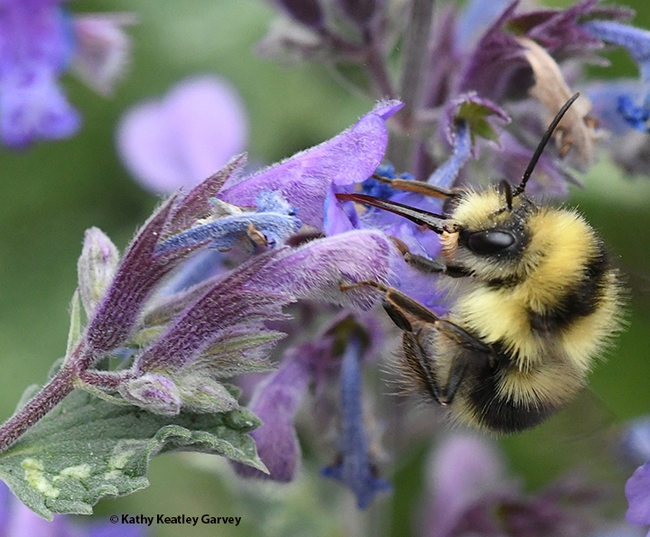
- Author: Kathy Keatley Garvey
Seen any bumble bees lately?
No? Me, neither.
It's almost the first day of spring, and bumble bees are as scarce as the proverbial hen's teeth. (Hens have no teeth, y'know.)
We've been watching our nectarine tree bloom. It's drawing honey bees, but no bumble bees.
Back on March 18, 2018, we spotted a number of bumble bees, including Bombus melanopygus, also known as the black-tailed bumble bee. This is one of the 27 species of bumble bees in California. We frequently see the yellow-faced bumble bee, Bombus vosnesenskii, and sometimes Bombus californicus, aka the California bumble bee.
Our March 18, 2018 "poster child" on our nectarine tree, Bombus melanopygus, appeared to be nesting nearby, due to her frequent visits.
National Public Radio reported on Feb. 6, 2020 that bumble bees are declining because of the extreme heat: "Extreme temperatures are driving a dramatic decline in bumble bees across North America and Europe, according to a new study, in yet another way climate change is putting ecosystems at risk.
"Researchers looked at half a million records showing where bumble bees have been found since 1901, across 66 different species. They found that in places where bumblebees have lived in North America, you're about half as likely to see one today. The decline is especially pronounced in Mexico, where bumble bees once lived in abundance."
Pesticides and habitat loss are also key factors. Says National Geographic in a Feb. 6, 2020 article titled Bumble Bees Are Going Extinct in a Time of 'Climate Chaos': "Climate change is not the only factor behind the insects' decline. They are also threatened by pesticides like neonicotinoids—which are extremely toxic to all bees—destruction of habitat by development and conversion of wildlands into agriculture, the spread of pathogens, and the release of non-native bees for commercial pollination."
If you're interested in learning more about bumble bees, check out the book, California Bees and Blooms: a Guide for Gardeners and Naturalists, the work of UC Davis and UC Berkeley scientists, including Robbin Thorp (1933-2019), distinguished emeritus professor of entomology at UC Davis, who also co-authored Bumble Bees of North America: an Identification Guide.
And if you see any bumble bees in your backyard in your yard between July 23 and Aug. 1, join the Third Annual Backyard Bumble Bee Count at https://www.inaturalist.org/projects/backyard-bumble-bee-count
As inaturalist.org says on its website: "Each bumble bee record submitted during the Backyard Bumble Bee Count helps researchers learn more about how bumble bees are doing and how to protect them and the environment we share. All observations collected July 23- August 1 will be included. For more information, including instructions, go to: https://backyardbbcount.wixsite.com/bumblebeecount."
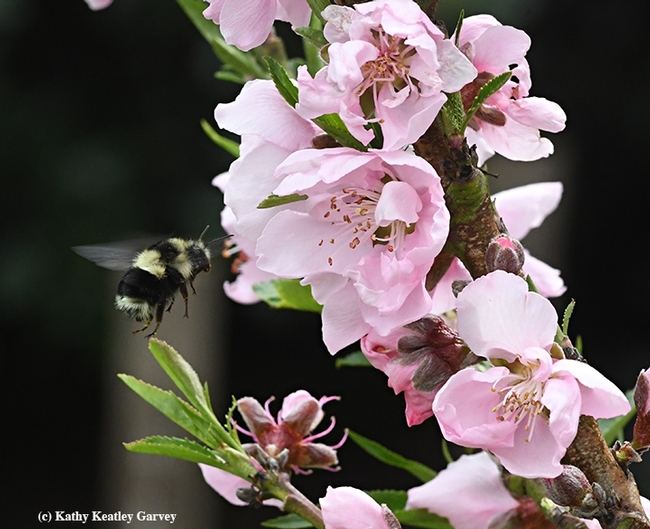
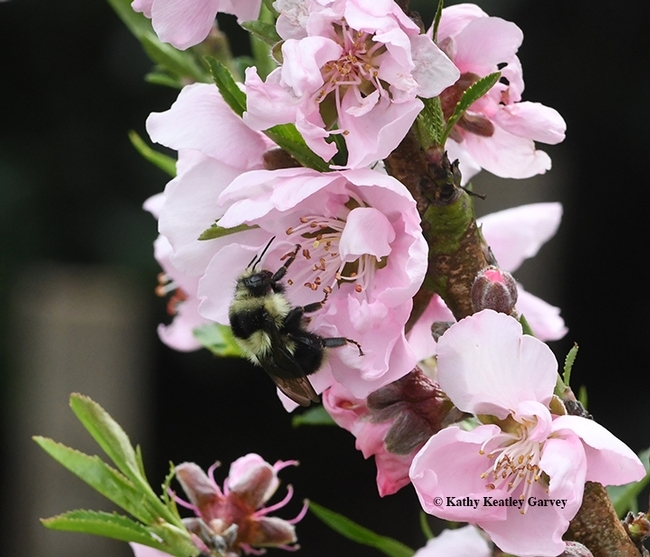
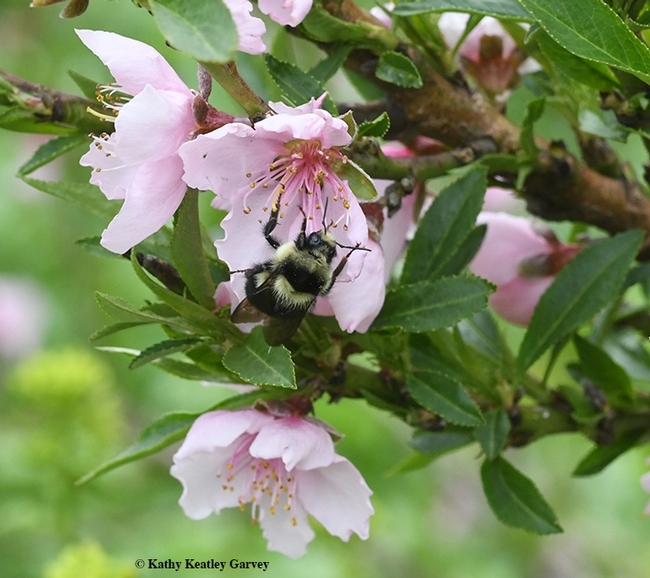
- Author: Kathy Keatley Garvey
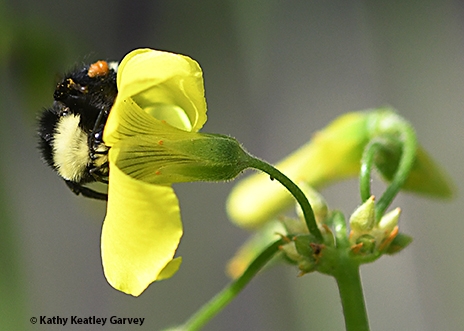
Yes, after a l-o-n-g, cold, hard winter, bumble bees are emerging.
At least in Solano County.
At 11:20 a.m. today (Wednesday, Jan. 13), we spotted a yellow-faced bumble bee, Bombus vosnesenskii, foraging on oxalis near downtown Benicia.
What a delight! A January bumble bee and the first one we've seen this year.
So, this is a good time to mention the inaugural Robbin Thorp First-Bumble-Bee-of-the-Year Contest, sponsored by the Bohart Museum of Entomology and coordinated by Bohart director Lynn Kimsey, UC Davis professor of entomology.
Just photograph a clearly identifiable bumble bee in the two-county area of Yolo or Solano, and submit it to bmuseum@ucdavis.edu with the time, date and place. The winner receives bragging rights and a special gift from the Bohart Museum. Plans call for a Bohart coffee mug with a bumble bee image.
The contest memorializes native pollinator specialist and Bohart associate Robbin Thorp (1933-2019), UC Davis distinguished emeritus professor of entomology. Professor Thorp, 85, who died June 7, 2019, was a global authority on bumble bees, and always looked forward to seeing the first bumble bee of the year. He launched an impromptu contest several years ago with a small group of bumble bee enthusiasts/photographers (including yours truly) from Yolo and Solano counties. (Note: I am not a contestant.)
Early Bumble Bees
The black-tailed bumble bee, Bombus melanopygus, is usually the first bumble bee to emerge in this area, Thorp used to say. It forages on manzanitas, wild lilacs, wild buckwheats, lupines, penstemons, clovers, and sages, among others. In early January, it's often seen on manzanita blossoms in the UC Davis Arboretum and Public Garden. B. vosnesenskii forages on such early bloomers as oxalis, jade, mustard and wild radish, and then on a variety of plants throughout the year. Both species are natives.
Thorp, a 30-year member of the UC Davis entomology faculty, from 1964-1994, co-authored two books, Bumble Bees of North America: An Identification Guide (Princeton University, 2014) and California Bees and Blooms: A Guide for Gardeners and Naturalists (Heyday, 2014). He achieved emeritus status in 1994 but continued to engage in research, teaching and public service until a few weeks before his death.
A tireless advocate of pollinator species protection and conservation, Thorp was known for his expertise, dedication and passion in protecting native pollinators, especially bumble bees, and for his teaching, research and public service. He was an authority on pollination ecology, ecology and systematics of honey bees, bumble bees, vernal pool bees, conservation of bees, native bees and crop pollination, and bees of urban gardens and agricultural landscapes.
Ready to join the hunt for the first bumble bee of the year in Yolo and Solano counties? Camera ready? Walking shoes laced? Go!
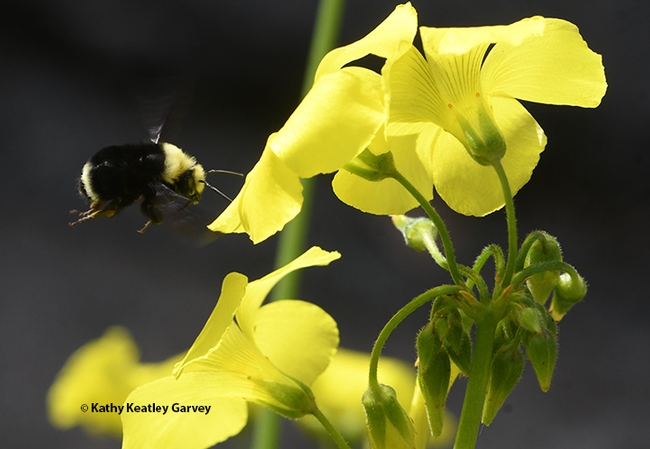
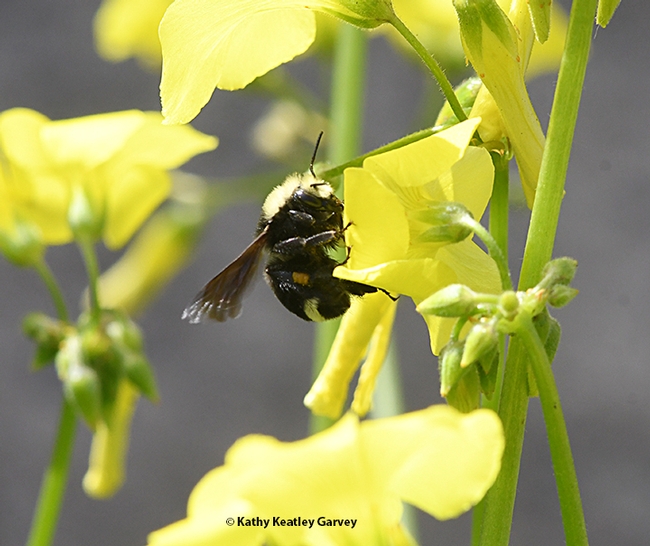
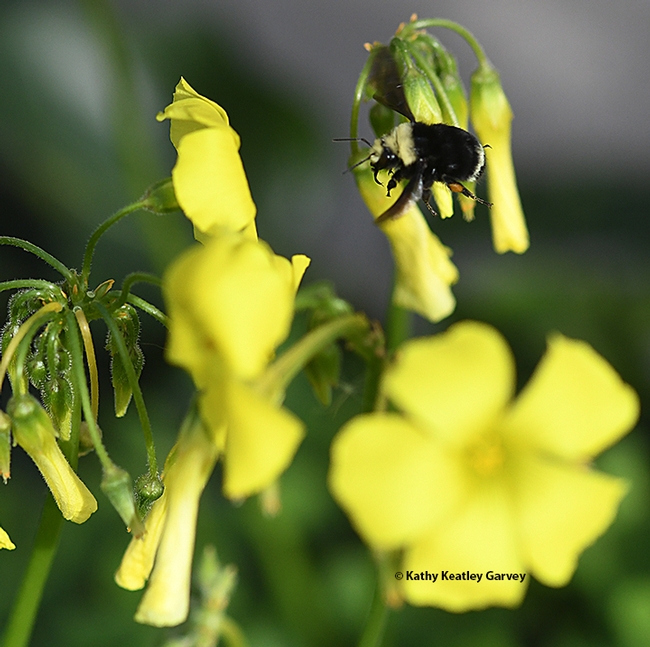
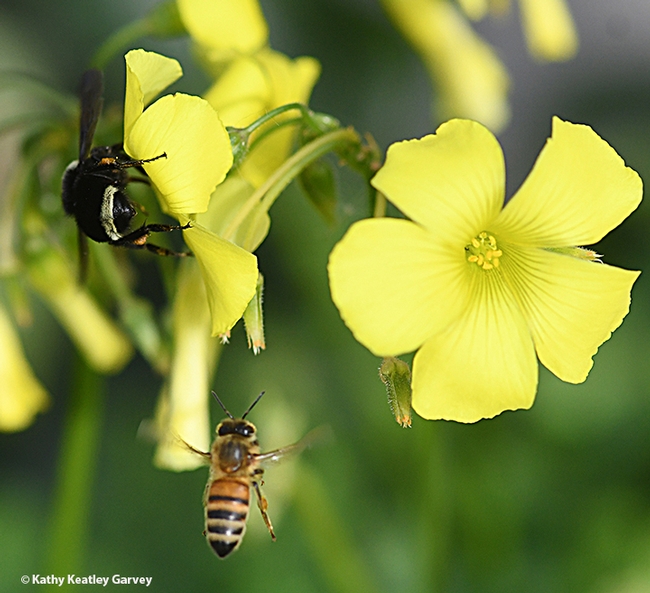
- Author: Kathy Keatley Garvey
Benjamin Franklin reportedly said: "Early to bed and early to rise, makes a man healthy, wealthy, and wise."
What about the sleeping patterns of bumble bees?
Bumble bees are definitely early risers--if the weather cooperates. They usually forage earlier than honey bees and also in cooler temperatures.
We spotted this bumble bee, Bombus melanopygus, commonly known as a "black-tailed bumble bee," sleeping on a Spanish lavender blossom April 12 in a Vacaville, Calif. park.
Native to western North America and found from California to British Columbia and as far east as Idaho, it forages on manzanitas, wild lilacs, wild buckwheats, lupines, penstemons, clovers, and sages, among others.
Keep your eye out for this bumble bee, which is the first species we see in this area. It will be the focus of the Robbin Thorp Memorial Bumble Bee Contest, which starts Jan. 1, 2021. The Bohart Museum of Entomology, directed by Lynn Kimsey, UC Davis professor of entomology, will sponsor the contest to see who can find the first one of the year.
Professor Thorp (1933-2019), a member of the UC Davis entomology faculty for 30 years, from 1964-1994, achieved emeritus status in 1994 but continued to engage in research, teaching and public service until a few weeks before his death. In 2014, during his retirement, he co-authored two books, Bumble Bees of North America: An Identification Guide and California Bees and Blooms: A Guide for Gardeners and Naturalists. He was among the instructors (2002-2019) of The Bee Course. This is an intensive nine-day workshop affiliated with the American Museum of Natural History and held annually at the Southwestern Research Station, Portal, Ariz. It's geared for conservation biologists, pollination ecologists, and other biologists who want to gain greater knowledge of the systematics and biology of bees.
For the past several years, several of us bumble bee enthusiasts, encouraged by Professor Thorp, have tried to find the first bumble bee of the year in the two-county area of Yolo and Solano. He always expressed delight when we reported back to him. This year Allan Jones of Davis photographed one on Jan. 6 on a white manzanita in the UC Davis Arboretum and Public Garden (Yolo County) to win the contest. The bumble bee been found as early as Jan. 1 in Benicia (Solano County).
Still, no matter the month, it's a joy to see. This one's for you, Robbin.
